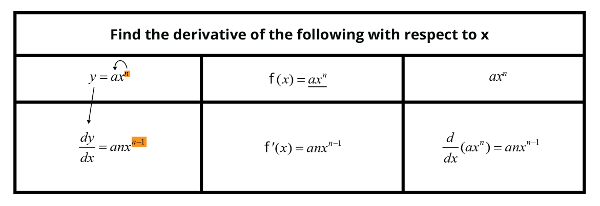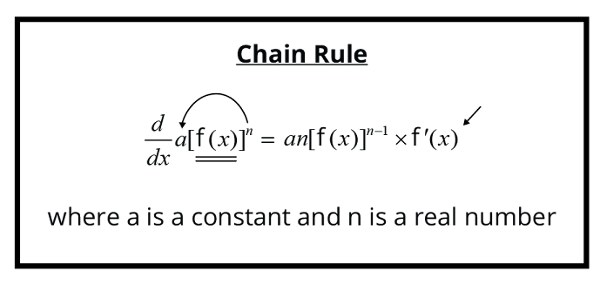Introduction To Differentiation
In this article, we will introduce the concepts of differentiation as per the Secondary 4 A Math coursework. We will learn about:
- The gradient of the curve at a point.
- Derivatives and gradient functions
- Differentiation of power functions
- Differentiation of composite functions using Chain Rule.
Gradient Of A Curve At A Point
The gradient of a curve at a point on the curve can be estimated by finding the gradient of the tangent at that point.

Derivative And Gradient Functions
Differentiation is a more accurate method of finding the gradient of a curve at any point.
There are three different ways to represent as follows,

The first row represents the equation form before differentiation.
The second row represents the equation form after differentiation.
Differentiation Of Power Functions

Find the derivative of the following with respect to \(\displaystyle{x}\)
- \(\displaystyle{y=a^n}\)
- In this type, the power \(\mathrm{n}\) needs to be multiplied by the coefficient.
- Then subtract 1 from the power.
Therefore after differentiation the equation becomes,
\(\displaystyle{\frac { dy } { dx } =anx^{n-1}}\)
- \(\displaystyle{f(x) = ax^n}\)
- In this type, add a prime (i.e \(f'\)) in between \(f(x)\).
- The power \(n\) needs to be multiplied with the coefficient.
- Then subtract 1 from the power.
Therefore after differentiation, the equation becomes as below.
\(f'(x)=anx^{n-1}\)
- \(\displaystyle{ax^n}\)
- In this type, write \(\displaystyle{\frac {d}{dx} }\) on the left hand side of the expression followed by the value in the question in brackets.
- The power \(\displaystyle{n}\) needs to be multiplied with the coefficient.
- Then subtract 1 from the power.
Therefore after differentiation the equation becomes,
\(\displaystyle{\frac { d } { dx } (a^n) = anx^{n-1}}\)
The above method works if the power \(\displaystyle{n}\) is a real number and \(\displaystyle{a}\) is not \(0\).
Example 1:
Differentiate the following with respect to \(x\).
- \(\displaystyle{y=3x^2}\)
- \(\displaystyle{f(x)={{1}\over 2}{x^3}}\)
- \(\displaystyle{-\frac25x^{-2}}\)
- \(\displaystyle{y=-2x^{\frac{1}{3}}}\)
Solution:
-
Following Type 1, mention the LHS as \(\displaystyle{\frac { dy } { dx }}\).
-
Then, multiply the power \(2\) with the coefficient and subtract 1 from the power.
\(\displaystyle{\frac { dy } { dx } =(2\times3)x^{2-1}}\)
\(\displaystyle{\frac { dy } { dx } =6x}\)
- \(\displaystyle{f(x)={{1}\over 2}{x^3}}\)
Solution:
-
For the LHS, add a prime (i.e \(f'\)) in between \(f\) and \((x)\).
-
For the RHS, multiply the power \(\displaystyle{\frac {1}{2}}\) with the co-efficient and subtract 1 from the power.
\(\displaystyle{f'(x) = (3 \times \frac12)x^{3-1}}\)
\(\displaystyle{f'(x) = \frac32x^{2}}\)
- \(\displaystyle{-\frac25x^{-2}}\)
Solution:
Add \(\displaystyle{\frac {d}{dx}}\) and in the brackets, multiply the power \(-2\) with the co-efficient and subtract 1 from the power.
\(\displaystyle{\frac { d } { dx } (-\frac {2}{5}x^{-2}) =\frac45x^{-3}}\)
D. \(\displaystyle{y=-2x^{\frac{1}{3}}}\)
Solution:
-
Following Type 1, mention the LHS as \(\displaystyle{\frac { dy } { dx } }\).
-
Then, multiply the power \(\displaystyle{\frac{1}{3}}\) with the co-efficient and subtract 1 from the power.
\(\begin{align} \displaystyle{\frac { dy } { dx }} &= \displaystyle{\bigg(-2 \times \frac13\bigg)x^{\big(-\frac {1}{3}-1\big)}}\\[2ex] &=\displaystyle{-\frac23x^{-\frac {2}{3}}} \end{align}\)
Laws Of Indices
These laws have a lot of usage in differentiation.
Positive indices
- \(\displaystyle{a^m \times a^n =a^{m+n}}\)
- \(\displaystyle{a^m \div a^n =a^{m - n}}\)
- \(\displaystyle{(a^m)^n = a^{mn}}\)
- \(\displaystyle{(ab)^n = a^{n} b^{n}}\)
- \(\displaystyle{\bigg(\frac {a}{b} \bigg)^n = \bigg(\frac {a^n} {b^n} \bigg)}\)
Negative and Zero indices
- \(\displaystyle{a^0 = 1}\)
- \(\displaystyle{\bigg(\frac {1}{a^n} \bigg) = a^{-n}}\)
Fractional indices
- \(\displaystyle{\sqrt [n]a = a^{\frac1n}}\)
- \(\displaystyle{\sqrt [n]{a^m} = a^{\frac mn}}\)
Example 2:
Differentiate of \(ax\) with respect to \(x\)
- Differentiate \(\displaystyle{y=5x^1}\) with respect to \(x\)
Solution:
-
Following the first type of differentiation, the LHS becomes \(\displaystyle{\frac { dy } { dx }}\).
-
In the RHS, the power 1 is multiplied with the coefficient 5 and subtracting the power 1 by 1.
\(\displaystyle{\frac { dy } { dx } = 5x^0}\)
The value of \(x^0\) is 1.
Therefore the answer is,
\(\displaystyle{\frac { dy } { dx } =5}\)
In summary, \(\displaystyle{\frac { d } { dx } (ax) = a}\) , where \(a\) is a constant.
- Differentiate \(\displaystyle{y=5}\) with respect to \(x\).
Solution:
Since there is no \(x\) in the question, it is difficult to differentiate.
You need to add \(x^0\) to it.
Therefore,
\(\displaystyle{y=5x^0}\)
Since, the value of \(x^0\) is 1, it does not change the question.
Hence, when you differentiate,
\(\begin{align} \frac { dy } { dx } &= (5 \times 0)x^{-1}\\[2ex] &= 0 \end{align}\)
In summary, \(\displaystyle{\frac{d}{dx} (a)=0}\), where \(a\) is a constant.
Example 3:
Differentiate \(\displaystyle{y = \frac {2} {x^2} + 5x + 3}\) with respect to \(x\).
Solution:
According to the laws of indices (negative and zero indices law 2), we are going to change the denominator to numerator \(\displaystyle{\frac {2} {x^2}}\) ,
Hence, you get
\(\displaystyle{y = {2} {x^{-2}} + 5x + 3}\)
Now you can differentiate it like you do normally,
- Multiply the power \(-2\) with the coefficient 2 and subtract the power \(-2\) with 1.
- As we saw in the last two examples, when you differentiate \(5x\) you get 5 and when you differentiate 3 you get 0.
\(\displaystyle{\frac { dy } { dx } =-4x^{-3} +5 +0}\)
Since, the final answer cannot be written in negative power, so we change the \(\displaystyle{x^{-3}}\) to the fractional form.
Hence, the answer is \(\displaystyle{\frac{dy}{dx} =-\frac {4}{x^{3}} +5}\)
Example 4:
Differentiate \(\displaystyle{\frac {4}{\sqrt {x}}}\) with respect to \(x\).
Solution:
Firstly the question needs to be converted to the \(\displaystyle{\frac { d } { dx } (ax^n)}\) form.
Square root can also be written as power \(\displaystyle{\frac{1}{2}}\), which gives us \(\displaystyle{\frac{d}{dx} \bigg[\frac {4}{x^{\frac12}}\bigg]}\)
The denominator \(\displaystyle{x^{\frac12}}\) is converted to numerator, thus becoming \(\displaystyle{\frac { d } { dx } (4x^{-\frac12})}\).
Then, differentiating this equation via multiplying the power \(\displaystyle{-\frac12}\) with the coefficient 4, and subtracting by 1, the equation becomes \(\displaystyle{-2x^{-\frac 32}}\).
Since the answer cannot be written in negative powers, \(\displaystyle{x^{^{-{3/_2}}}}\) is converted to the fractional form , i.e. \(\displaystyle{- \frac {2}{x^{^3/_2}}}\)
\(\displaystyle{x^{^{3/_2}}}\) can also be written as \(\displaystyle{\sqrt {x^3}}\).
Therefore, the answer is \(\displaystyle{- \frac {2} {\sqrt {x^3} }}\).
Example 5:
Differentiate \(\displaystyle{y= 2x^3 - {\sqrt {3} } - { \frac {5}{\sqrt {x}} }}\) , with respect to \(x\).
Solution:
Rewrite the question by converting the denominator at \(\sqrt{x} \) to \(x^{-1/2}\) ,
\(\displaystyle{y= 2x^3 - {\sqrt {3} } - { 5x^{-\frac12} }}\)
Now differentiating,
The coefficient is multiplied with the powers and then the powers are subtracted by 1,
\(\displaystyle{\frac { dy } { dx } =6x^2 + \frac {5}{2}x^{-\frac 32}}\)
The \(x^{-\frac32}\) is converted into denominator.
\(\displaystyle{\frac { dy } { dx } = 6x^2 + {\frac {5}{2x^{\frac32}}}}\)
The \(\displaystyle{x^{\frac32}}\) in the above equation is written as \(\sqrt{x^{3}} \).
Therefore the answer is,
\(\displaystyle{\frac { dy } { dx } = 6x^2 + {\frac {5}{2\sqrt {x^{3}}}}}\)
Differentiation Of Composite Functions
Now that we have learnt how to differentiate power function, have you wondered how can we find the derivative of composite functions like \(\displaystyle{y=(3x^2+5)^{\frac12} }\)?
For this type of differentiation we need to use the chain rule.
Let us take the equation,
\(\displaystyle{\frac { d } { dx } \big(a[f(x)]^n\big)}\),
where \(a\) is a constant and \(n\) is a real number.
The power \(n\) outside the brackets should be multiplied with the coefficient outside the brackets and subtract 1 from the power, let's assume this as Equation 1.
\(an[f(x)]^{n-1}\) ---------- Equation (1)
Then, differentiate the equation in the bracket and multiply it with the equation 1.
Therefore, it becomes
\(\displaystyle{an[f(x)]^{n-1} \times f'(x)}\)

Example 6:
Differentiate the following with respect to \(x\).
- \(\displaystyle{y=(3x^2+5)^{12}}\)
Solution:
Multiply the power 12 with the coefficient 1.
Then, differentiate the equation in brackets and multiply it.
\(\displaystyle{\frac { dy } { dx } =12(3x^2+5)^{11} \times6x}\)
Simplifying the above equation,
\(\displaystyle{\frac { dy } { dx } =72x(3x^2+5)}\)
Therefore, the answer to the question (a) is,
\(\displaystyle{\frac { dy } { dx } =72x(3x^2+5)}\)
Differentiate the following with respect to \(x\).
- \(\displaystyle{f(x)=\sqrt {2x-3}}\)
Solution:
Let us rewrite the question by rewriting the \(\displaystyle{\sqrt {2x-3}}\) as \(\displaystyle{(2x-3)^{\frac12}}\),
Therefore, the equation becomes \(\displaystyle{f(x)=(2x-3)^{\frac12}}\)
Multiply the power \(\displaystyle{\frac12}\) with the coefficient 1 and subtract the power with 1.
Then, differentiate the equation in the bracket and multiply it.
Therefore, the equation becomes,
\(\displaystyle{f'(x)=\frac {1}{2}(2x-3)^{-\frac12} \times 2}\)
The 2 in numerator and 2 in denominator in the above equation cancels each other,
\(\displaystyle{f'(x)=(2x-3)^{-\frac12}}\)
Since the answers cannot have negative powers,
\(\displaystyle{f'(x)= \frac{1}{\sqrt {(2x-3)} }}\)
Therefore the answer for the question (b) is \(\displaystyle{f'(x)= \frac{1}{\sqrt {(2x-3)} }}\)
Differentiate the following with respect to \(x\).
- \(\displaystyle{\frac {1}{(2-3x)^2}}\)
Solution
Rewriting the question by converting the denominator \(\displaystyle{(2-3x)^2}\) into the negative power form, we get \(\displaystyle{(2-3x)^{-2}}\) .
Differentiating the above equation by multiplying the power with the coefficient and subtracting the power with 1, and following by differentiating the function in the bracket.
we get,
\(\begin{equation} -2(2-3x)^{-3} \times ({-3}) = 6(2-3x)^{-3} \end{equation}\)
Since the answers cannot be written in negative powers, converting \(\displaystyle{(2-3x)^{-3}}\) into denominator.
\(\displaystyle{f'(x) = \frac {6}{(2-3x)^3}}\)
Therefore the answer for the question (c) is.
\(\displaystyle{f'(x) = \frac {6}{(2-3x)^3}}\)
Conclusion
In the article, we learned about differentiation as per the Secondary 4 A Maths coursework. We understood the basics of differentiation, how to differentiate using the law of indices and chain rule.
| Continue Learning | |
|---|---|
| Introduction To Differentiation | Applications Of Differentiation |
| Differentiation Of Exponential And Logarithmic Functions | Integration Techniques |
| Applications Of Integration | |


 SG
SG  VN
VN 















